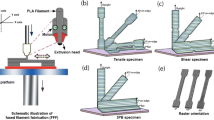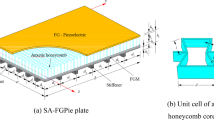Abstract
Pultrusion being the viable and economical process for producing constant cross-section composite products, many variants of it are being tried out. This paper embarks on the pultrusion with multi-materials; typically of polymer foam/glass fibre reinforced polymer (GFRP) sandwich panels. Unlike conventional composites pultrusion, this process with more than two material phases, one of them dry, poses a challenge in simulating the thermal co-curing within the die. In this paper, the formulation and development of three-dimensional, finite element/nodal control volume (FE/NCV) approach for such multi-material pultrusion is presented. The numerical features for handling the dry-wet material interfaces, material shrinkage, variations in pull speed and die heating, and foam-to-skin thickness ratio are discussed. Implementation of the FE/NCV procedure and its application in analyzing pultrusion of polymer foam/GFRP sandwich panels with multi-heater environment are presented.








Similar content being viewed by others
References
Sumerak, J.E.: The pultrusion process for automated manufacture of engineered composite profiles. In: Mallick, P.K. (ed.) Composites engineering handbook, Chapter 11, pp. 549–577. Marcel Dekker Inc (1997)
Advani, S.G., Sozer, E.M.: Process modeling in composites manufacturing, pp. 146–151. Marcel Dekker Inc, USA (2003)
Valliappan, M., Roux, J.A., Vaughan, J.G., Arafat, E.S.: Die and post-die temperature and cure in graphite/epoxy composites. Compos B 27B(1), 1–9 (1996)
Viola G., Portwood T., Ubrich P., DeGroot H.R.: Numerical optimization of pultrusion line operating parameters, 35th International SAMPE Symposium, 1, 1968–1975 (1990)
Wilcox, J.A.D., Wright, D.T.: Towards pultrusion process optimization using artificial neural networks. J Mater Process Technol 83(1–3), 131–141 (1998)
Chachad, Y.R., Roux, J.A., Vaughan, J.G.: Three-dimensional characterization of pultruded fiberglass-epoxy composite materials. J Reinf Plast Compos 14, 495–512 (1995)
Suratno, B.R., Ye, L., Mai, Y.W.: Simulation of temperature and curing profiles in pultruded composite rods. Compos Sci Technol 58, 192–197 (1998)
Liu, X.L., Crouch, I.G., Lam, Y.C.: Simulation of heat transfer and cure in pultrusion with a general-purpose finite element package. Compos Sci Technol 60, 857–864 (2000)
Joshi, S.C., Lam, Y.C.: Three-dimensional FE/NCV simulation of pultrusion process with temperature-dependent material properties including resin shrinkage. Compos Sci Technol 61, 1539–1547 (2001)
Joshi, S.C., Lam, Y.C., Tun, U.W.: Improved cure optimization in pultrusion with pre-heating and die-cooler temperature. Compos A 12(3), 1151–1159 (2003)
Li, S.J., Xu, L.Q., Ding, Z.M., Lee, L.J.: Experimental and theoretical analysis of pulling force in pultrusion and resin injection pultrusion (RIP)-Part II: molding and simulation. J Compos Mater 37, 195–216 (2003)
Carlone, P., Palazzo, G.S., Pasquino, R.: Pultrusion manufacturing process development by computational modeling and Methods. Math. Comput. Model. 44, 701–709 (2006)
Carlone, P., Palazzo, G.S., Pasquino, R.: Pultrusion manufacturing process development: cure optimization by hybrid computational methods. Comput. Math. Appl. 53, 1464–1471 (2007)
Haj-Ali, R.M., Zureick, A.H., Kilic, M.H., Steffen, R.: Three-dimensional micromechanics-based constitutive framework for analysis of pultruded composite structures. J Eng Mech 127, 653–660 (2001)
Muliana, A.H., Haj-Ali, R.: A multi-scale framework for layered composites with thermo-rheologically complex behaviors. Int J Solids Struct 45(10), 2937–2963 (2008)
Batch, G.L., Macosko, C.W.: Heat transfer and cure in pultrusion: model and experimental verification. AlChE J 39(7), 1228–1241 (1993)
Britnell, D.J., Tucker, N., Smith, G.F., Wong, S.S.F.: Bent-pultrusion-a new method for the manufacture of pultrudate with controlled variation in curvature. J Mater Process Technol 138, 311–315 (2003)
Alberto, C., Rizzi, E., Papa, E.: Experimental characterization and numerical simulations of a syntactic foam/glass-fibre composite sandwich. Compos Sci Technol 60, 2169–2180 (2000)
Ben, G., Shoji, A.: Pultrusion techniques and evaluations of sandwich beam using phenolic foam composite. Adv Compos Mater 14(3), 277–288 (2005)
Kosar, V., Gomzi, Z.: Thermal effects of cure reaction for an unsaturated polyester in cylindrical moulds. Chem Biochem Eng Q 15(3), 101–108 (2001)
LUSAS 13.0, Theory and user’s manuals, FEA Limited, Surrey, UK (1998)
Pittman J.F.T.: Finite elements for field problems, Chapter 6, Fundamentals of polymer processing. In: Tucker, C.L. (ed.) (1986)
Author information
Authors and Affiliations
Corresponding author
Rights and permissions
About this article
Cite this article
Joshi, S.C., Chen, X. Time-Variant Simulation of Multi-Material Thermal Pultrusion. Appl Compos Mater 18, 283–296 (2011). https://doi.org/10.1007/s10443-010-9156-9
Received:
Accepted:
Published:
Issue Date:
DOI: https://doi.org/10.1007/s10443-010-9156-9




